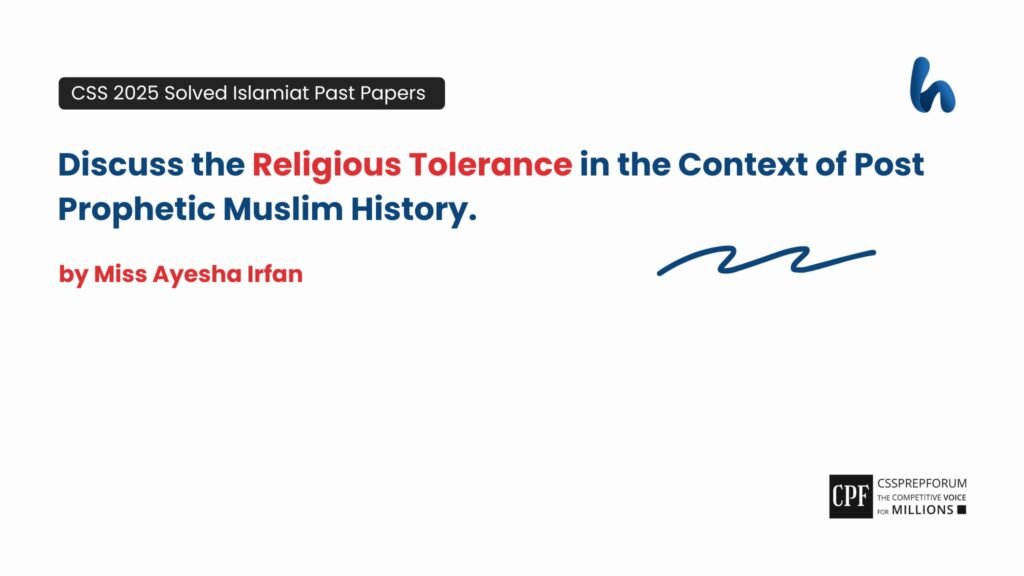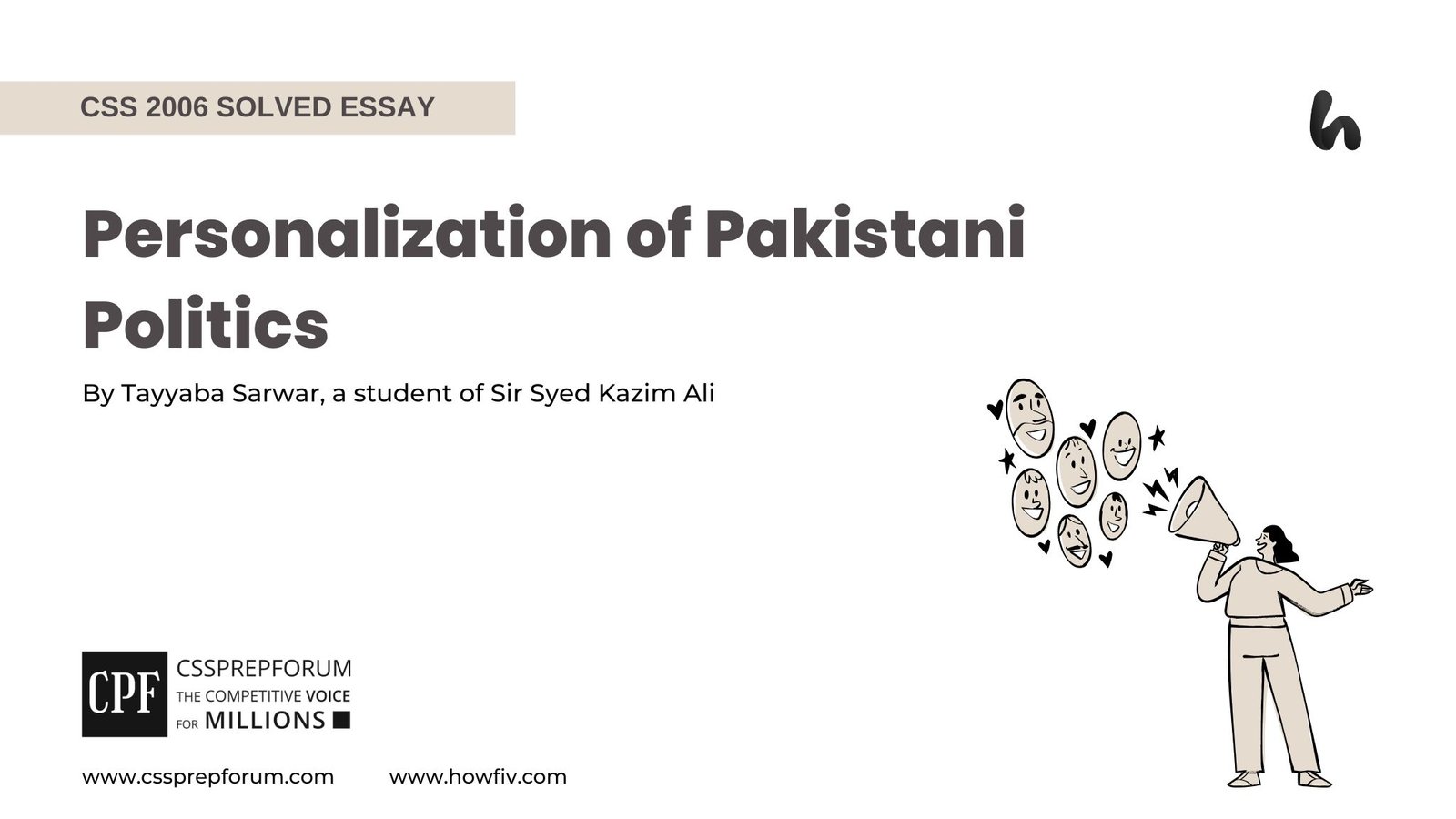CSS 2025 Solved Islamiat Past Papers | The Religious Tolerance in the Post-Prophetic Muslim History
The following question of CSS Islamiat 2025 is solved by Miss Ayesha Irfan, the highest scorer in CSS Islamiat. Moreover, the question is attempted using the same pattern taught by Sir Syed Kazim Ali to his students, who have scored the highest marks in compulsory subjects for years. This solved past paper question is uploaded to help aspirants understand how to crack a topic or question, write relevantly, what coherence is, and how to include and connect ideas, opinions, and suggestions to score the maximum.

Question Breakdown
The examiner has asked to describe the Religious Tolerance in the Context of Post Prophetic Muslim History. This question demands the importance of Religious Tolerance in the Context of post-prophetic Muslim History. You need to shed light on the significance of religious tolerance by explaining the main question for getting good grades. Finally, end your answer with a critical analysis and a conclusion.
Outline
1-Introduction
2-Meaning and significance of the term religious tolerance
3-Religious Tolerance in the Context of Post-Prophetic Muslim History
3.1-Religious Tolerance in the Rashidun Caliphate (632–661 CE)
- ✓ In the Era of Abu Bakr (RA)
- ✓ In the Era of Umar ibn al-Khattab (RA)
- ✓ In the Era of Uthman ibn Affan (RA)
- ✓ In the Era of Ali ibn Abi Talib (RA)
3.2-Religious Tolerance Under the Umayyad Caliphate (661–750 CE)
3.3-Religious Tolerance in the Abbasid Caliphate (750–1258 CE)
3.4-Religious Tolerance in Muslim Spain (Al-Andalus, 711–1492 CE)
3.5-Religious Tolerance in the Ottoman Empire (1299–1924 CE)
3.6-Religious Tolerance in the Mughal Empire (1526–1857 CE)
4-Challenges to Religious Tolerance in Post-Prophetic Muslim History
- ✓ Political exploitation of religion
- ✓ Sectarian conflicts and their impact on religious coexistence
- ✓ Colonial intervention and Western influence
- ✓ Modern-day implications, including challenges in upholding Islamic values
5-Critical Analysis
6-Conclusion

Answer to the Question
Introduction
Islamic rule has promoted interfaith harmony and been a beacon of religious tolerance throughout history. Muslim monarchs enacted laws that protected the rights of non-Muslim people based on the Quran’s teaching that “There is no compulsion in religion” (Al-Baqarah 2:256) and the Prophet Muhammad’s (PBUH) model of interfaith cooperation. Various Muslim dynasties supported religious freedom ideals, from the Rashidun Caliphate’s fair government to the intellectual blossoming of the Abbasids, the Ottoman Millet system, and the inclusion of the Mughals. However, these values have occasionally been stressed by issues like political disputes, colonial intrusions, and sectarian tensions. Examining these historical models offers important lessons for promoting interfaith cooperation in contemporary cultures.

Meaning and significance of the term religious tolerance
Religious tolerance is the capacity of people and communities to accept and live in harmony with those who practice and believe in other religions without prejudice or compulsion. In varied cultures, it is a key value that fosters social harmony, respect for one another, and peaceful coexistence. The teachings of the Quran and the Prophet Muhammad’s (PBUH) Sunnah are the foundation of religious tolerance in Islam. For instance, according to the Quran, “To you be your religion, and to me be mine” (Al-Kafirun 109:6). This idea entails the active defence of religious freedom, upholding justice, and promoting interfaith understanding rather than just passive acceptance. Islamic societies have historically respected these ideals, allowing non-Muslims both legal and religious freedom. In today’s world, religious tolerance remains vital for promoting global peace, reducing sectarian conflicts, and building inclusive societies where people of all faiths can thrive together.
Religious Tolerance in the Context of Post-Prophetic Muslim History
3.1-Religious Tolerance in the Rashidun Caliphate (632–661 CE)
- ✓ In the Era of Abu Bakr (RA)
The era of Caliph Abu Bakr (RA) set a strong foundation for religious tolerance in the early Islamic state, emphasizing justice, coexistence, and the protection of non-Muslim communities. He maintained the Islamic tenet that faith cannot be forced onto anybody, as he led the Muslim Ummah after the Prophet Muhammad (PBUH). His renowned directives to his military leaders demonstrated his dedication to religious tolerance, especially in the fight against insurgents and outside threats. He specifically ordered, “Do not kill monks in monasteries, do not destroy places of worship, and do not harm non-combatants.” The protection of Christian, Jewish, and other religious groups under Islamic control was guaranteed by this decree. Additionally, by upholding the contracts already in place with non-Muslims, Abu Bakr (RA) guaranteed their safety under Islamic rule while permitting them to practice their faith freely. His administration exemplified fairness, religious liberty, and peaceful cohabitation, influencing the Islamic government even after the prophecy.
- ✓ In the Era of Umar ibn al-Khattab (RA)
Moreover, in Islamic history, the time of Caliph Umar ibn al-Khattab (RA) is a noteworthy illustration of religious tolerance, characterized by fairness, inclusion, and regard for non-Muslim populations. The Treaty of Jerusalem (637 CE), in which he guaranteed the safety of Christian sacred places and offered religious freedom to its residents, is one of the most important examples of his dedication to religious harmony. The contract clarified, “This is the assurance of safety which the servant of Allah, Umar, the Commander of the Faithful, grants to the people of Jerusalem… Their churches shall not be taken, destroyed, or diminished, nor shall they or their crosses be harmed.” The Quran’s teaching that “There is no compulsion in religion” (Al-Baqarah 2:256) was reflected in this accord, which became an example of interfaith tolerance. Furthermore, Umar (RA) established the Dhimmi system, which guaranteed non-Muslims’ rights under Islamic law and permitted them to preserve their cultural and religious identities while still being treated as equal members of society. His leadership established a standard for upcoming Islamic governments by proving that justice, equity, and respect for all religions are the foundations of genuine governance.
- ✓ In the Era of Uthman ibn Affan (RA)
Furthermore, Uthman ibn Affan’s (RA) caliphate was distinguished by substantial economic growth, geographical expansion, and the unification of administrative practices that supported religious tolerance. Uthman (RA) maintained the Islamic legal system that guaranteed the safety and religious freedom of non-Muslim people as the Islamic empire expanded to encompass areas with sizable Christian, Jewish, and Zoroastrian populations. Following the example set by his forebears, Muhammad allowed non-Muslims to freely practice their religion and continue to run their institutions without hindrance. The Dhimmi system was further formalized under his reign, allowing non-Muslims to exercise self-governance over religious and legal concerns and avoiding military duty in return for Jizya. This levy guaranteed their governmental protection. The Islamic regulations were reinforced by historical documents showing that churches, synagogues, and fire temples were all still standing and that no forced conversions were carried out. Additionally, Uthman (RA) established progressive economic policies that promoted religious harmony and social stability by guaranteeing fair resource allocation that benefited both Muslim and non-Muslim groups. His rule established religious tolerance as a fundamental tenet of the growing Muslim empire and embodied the Islamic values of justice, inclusion, and pluralism.
- ✓ In the Era of Ali ibn Abi Talib (RA)
Likewise, Ali ibn Abi Talib’s (RA) reign was a time of internal conflict, yet he persisted in defending justice, religious tolerance, and the safety of non-Muslim populations. He upheld the Quran’s teaching of justice and non-coercion in faith (Al-Baqarah 2:256) by ensuring that Christians, Jews, and other religious minorities maintained their rights under Islamic rule in spite of political unrest. In his writings and governance, Ali (RA) emphasized that Dhimmi communities should be treated with fairness and dignity, and he vehemently condemned religious persecution in all its forms. His well-known order to Egypt’s governor, Malik al-Ashtar, stated, “People are of two kinds: either your brothers in faith or your equals in humanity.” This principle guided his policies, ensuring the protection of life, property, and religious freedom for all. Despite sectarian challenges, Ali (RA) upheld the Islamic ideals of coexistence, ethical governance, and interfaith harmony, reinforcing the legacy of religious tolerance in early Islamic history.
3.2-Religious Tolerance Under the Umayyad Caliphate (661–750 CE)
Moving down the ladder, the Umayyad Caliphate (661–750 CE) established the Dhimmi system, which gave non-Muslims legal protection and religious autonomy in return for the Jizya tax and ruled over a sizable and diversified populace. According to historical accounts, Christians accounted for about half of the population, while Jews and Zoroastrians flourished in places like Cordoba and Damascus. Non-Muslims held key positions in administration, such as the Christian scholar John of Damascus, who worked for Caliph Abd al-Malik. The caliphate’s policy of non-interference in issues of faith was reflected in the preservation of religious landmarks. This age strengthened the Quranic notion of religious freedom by striking a balance between administration and religious diversity.
3.3-Religious Tolerance in the Abbasid Caliphate (750–1258 CE)
Furthermore, the Abbasid Caliphate (750–1258 CE) was a time of great religious tolerance, cultural interchange, and intellectual growth. The Abbasids maintained the Dhimmi system, which gave Christians, Jews, and Zoroastrians security, religious freedom, and important positions in government. Their realm was large and included people of many different religions. Muslim, Christian and Jewish academics collaborated to translate and preserve Greek, Persian, and Indian knowledge in the Baghdad House of Wisdom (Bayt al-Hikmah), which developed into a hub for interfaith research. According to historical accounts, Jews and Christians worked as doctors, academics, and administrators. One such individual was the Nestorian Christian physician Hunayn ibn Ishaq. The religious conversation was encouraged by caliphs such as Harun al-Rashid and Al-Ma’mun, who ensured non-Muslims freely practised their faith and contributed to society. This period exemplified Islamic governance based on justice, knowledge, and coexistence, reinforcing the Quranic principle of no compulsion in religion (Al-Baqarah 2:256).
3.4-Religious Tolerance in Muslim Spain (Al-Andalus, 711–1492 CE)
In Islamic history, the Muslim period (Al-Andalus, 711–1492) is among the most well-known instances of intellectual prosperity, cultural cooperation, and religious tolerance. Muslims, Christians, and Jews coexisted and collaborated under leaders such as Abd al-Rahman III (r. 912–961 CE) and Al-Hakam II (r. 961–976 CE), which aided in the progress of the area’s economy, art, and science. Churches and synagogues continued to operate under the dhimmi system, guaranteeing non-Muslims their religious liberty. During this time, Christian intellectuals who attended Arabic universities and renowned Jewish academics like Maimonides (Musa ibn Maymun) rose to prominence. Interfaith cooperation flourished in places like Cordoba, Toledo, and Granada, where academics translated Greek and Latin books into Arabic, which subsequently impacted the European Renaissance. Despite fluctuations in policies, Al-Andalus remains a testament to Islam’s commitment to justice, religious freedom, and pluralism, aligning with the Quranic principle, “To you be your religion, and to me be mine” (Al-Kafirun 109:6). As a result, a fundamental tenet of this society was religious freedom.
3.5-Religious Tolerance in the Ottoman Empire (1299–1924 CE)
Except for these, one of the most enduring Islamic empires, the Ottoman Empire (1299–1924), was renowned for its tolerance of all religions and its multiculturalism. Through the Millet System, which gave Christians, Jews, and other religious communities autonomy in questions of personal and religious faith, the Ottomans established religious freedom. One such instance is the seizure of Constantinople in 1453 by Sultan Mehmed II (r. 1451–1481 CE), who restored Patriarch Gennadius II and guaranteed the safety of the Orthodox Christian community, giving him control over Christian matters. Similarly, during the Spanish Inquisition, Jewish exiles who had been banished from Spain in 1492 were welcomed by Sultan Bayezid II (r. 1481–1512 CE), who gave them a safe haven in Ottoman territories, especially Istanbul and Thessaloniki. In the Ottoman court, Joseph Nasi, a Jewish philosopher, even became a well-known political counsellor. Aligned with the Quranic scripture, “Allah does not forbid you to deal justly and kindly with those who have not fought you because of your religion” (Al-Mumtahanah 60:8). These policies mirrored Islamic values of fairness and coexistence. Thus, religious diversity was guaranteed by the Ottoman form of government, enabling several religions to flourish under Islamic control.
3.6-Religious Tolerance in the Mughal Empire (1526–1857 CE)
Last but not least, the Mughal Empire (1526–1857 CE) promoted religious harmony and tolerance, especially under leaders like Shah Jahan, Dara Shikoh, and Jahangir. Emperor Jahangir (r. 1605–1627 CE) had friendly connections with Sikh and Hindu leaders and let Christian missionaries preach freely. Despite being renowned for his ambitious construction endeavours, Shah Jahan (r. 1628–1658 CE) also fostered religious unity by supporting interfaith academics and allocating land for Hindu temples. Believing in the interconnectedness of faiths, his son, a prince with a Sufi leaning, translated the Upanishads and Bhagavad Gita into Persian. Sikh leader Guru Tegh Bahadur was originally revered until subsequent problems erupted. At the same time, Hindu officials such as Raja Jai Singh kept important places in the government even throughout Aurangzeb’s reign (r. 1658–1707 CE) despite the tougher regulations. These policies were influenced by Islamic principles of justice and pluralism, echoing the Quranic verse, “Allah does not forbid you to deal justly and kindly with those who have not fought you because of your religion” (Al-Mumtahanah 60:8). Despite periods of tension, the Mughal Empire largely fostered an environment where Muslims, Hindus, Christians, and Sikhs coexisted and contributed to a thriving civilization.
Challenges to Religious Tolerance in Post-Prophetic Muslim History
- ✓ Political exploitation of religion
First and foremost, the political exploitation of religion has posed a serious threat to religious tolerance throughout post-Prophetic Muslim history, frequently resulting in persecution and sectarian strife. According to historical accounts, intellectuals were punished during the Mihna (Islamic Inquisition, 833–848 CE) during the Abbasid dynasty for having different theological beliefs, especially over the Quran’s created character. Similar to this, Shi’a Islam was proclaimed the official religion of the Safavid Empire (1501–1736 CE), which resulted in the persecution of Sunnis and the forcible conversion of Sunnis. Religious groups have been politically influenced in the 20th and 21st centuries; statistics indicate that 60–70% of Middle Eastern wars are the result of sectarian violence (Pew Research Center, 2017). The Quran’s arguments for justice and unity have been undermined by rulers and political bodies using religion as a weapon for power, from the Ottoman-Safavid struggle to contemporary splits (Al-Hujurat 49:10).
- ✓ Sectarian conflicts and their impact on religious coexistence
Second, throughout post-Prophetic Muslim history, sectarian wars have had a significant negative influence on religious cohabitation, frequently resulting in violence, relocation, and profound societal divides. Sunni-Shi’a tensions were heightened by the Ottoman-Safavid rivalry (16th–18th centuries), which destabilized areas like Iraq and Persia via forced conversions and mass murders. Hindu-Muslim ties deteriorated during the Mughal collapse (18th century) as a result of sectarian conflict in the Indian subcontinent. According to studies, sectarian violence now makes up around 70% of religious disputes in the Middle East (Pew Research Center, 2017), with nations like Syria, Lebanon, and Iraq suffering from protracted instability. As the Quran emphasizes, “And hold firmly to the rope of Allah all together and do not become divided” (Aal-e-Imran 3:103). Such disputes undercut the Islamic values of justice and togetherness. These differences have eroded Muslim civilizations, leaving them open to internal conflict and outside influence.
- ✓ Colonial intervention and Western influence
Third, Religious tolerance in the Muslim world has been severely disrupted, sectarian divisions have been exacerbated, and Islamic unity has been weakened as a result of colonial involvement and Western influence. European nations like Britain and France used a divide-and-rule policy throughout the colonial era (18th–20th century), which exacerbated ethnic and sectarian conflicts. For example, British policies in India stoked Hindu-Muslim tensions, leading to the Partition of 1947, which resulted in over 1 million deaths and the displacement of 15 million people, while the British mandate in Iraq (1920–1932) exacerbated Sunni-Shi’a divisions by favouring a Sunni-dominated government. In the present day, sectarian violence has increased as a result of greater destabilization caused by Western geopolitical operations, such as the 2003 U.S. invasion of Iraq. In violation of the Quranic concept, “And do not let the hatred of a people prevent you from being just” (Al-Ma’idah 5:8), such actions have weakened the Islamic ideal of coexistence. In Muslim communities, colonial and Western influences have created enduring splits by taking advantage of religious and ethnic distinctions, making religious concord difficult to maintain.
- ✓ Modern-day implications, including challenges in upholding Islamic values
Fourth, due to political unrest, ideological radicalism, and globalization, it has become more difficult to preserve Islamic principles while allowing for religious tolerance in the present period. Debates about Sharia law, secularism, and minority rights demonstrate how difficult it is for many countries with a majority of Muslims to strike a balance between their religious beliefs and modern administration. Interfaith relations have become even more strained as a result of growing Islamophobia in the West and radical forces inside Muslim communities. In Muslim-majority nations, sectarian violence and political unrest have resulted in the persecution of religious minorities, including Christians in the Middle East and Rohingya Muslims in Myanmar, while 64% of Muslims in Europe report feeling discriminated against, according to a 2018 World Bank research. Furthermore, traditional Islamic principles have been questioned by Western cultural impact, leading to identity problems among young Muslims.
Critical Analysis
A critical analysis of religious tolerance in post-prophetic Muslim history reveals that while Islamic teachings promote coexistence, political ambitions, sectarianism, and colonial interventions have often undermined these ideals. The Rashidun, Umayyad, Abbasid, Ottoman, and Mughal periods showcased varying levels of tolerance, yet power struggles and sectarian conflicts frequently disrupted harmony. Western influence and modern ideological extremism have further deepened divisions, making religious coexistence an ongoing challenge. Despite these obstacles, Islamic principles of justice and pluralism remain a strong foundation for rebuilding tolerance and unity in the modern world.
Conclusion
In conclusion, religious tolerance in post-Prophetic Muslim history has been shaped by a delicate balance between Islamic principles, political dynamics, and external influences. While Islam advocates justice, coexistence, and respect for diversity, historical realities often deviated due to sectarianism, power struggles, and colonial interventions. Despite challenges, various Muslim empires fostered multicultural societies where different faiths coexisted. However, modern issues such as extremism, political exploitation of religion, and Western influence continue to threaten religious harmony. To uphold Islamic values of tolerance and justice, Muslim societies must revive the spirit of inclusivity and ethical governance, ensuring peaceful coexistence in an increasingly interconnected world.

CSS 2025 Solved Islamiat Paper
Searching for CSS or PMS Solved Islamiat Past Papers?
Are you preparing for CSS or PMS and searching for solved Islamiat past papers, notes, books, PDFs, and MCQs? Explore them for free on Howtests and Cssprepforum. All content is fully solved and written by Miss Ayesha Irfan. For your convenience, the links are provided below, simply click on any to start reading and preparing.












